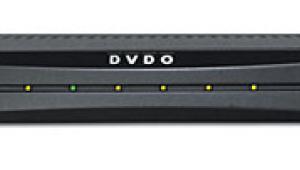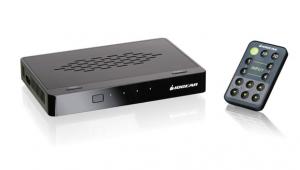Camelot Technology Dragon 5.1 Plus

Camelot Technology is a small, technologically savvy company that specializes in creating products for particular high-end applications, and they have a knack for creating devices that enhance the performance of other products. The Dragon 5.1 Plus is an interface box designed to cope with all the digital datastreams that emanate from a DVD transport, CD player, or satellite receiver. Standard PCM signals, Dolby Digital, DTS, and even higher bit rates, such as 96kHz, should pass through the Dragon 5.1 Plus without suffering the indignities of code-stripping or data rape. The Dragon promises to reclock digital signals and reduce jitter without singeing a single bit. That's some friendly lizard.
The Dragon Outside
The Dragon's lair, with thick, black anodized front panel, is thin enough to fit in a small space above your DVD player or A/V processor. It can accept up to three digital inputs (not counting two proprietary I2S inputs used by Audio Alchemy and Camelot) and transform any of them into a coaxial or AES/EBU output. (The I2S signals remain in their own format.) If you have a disc player with TosLink digital outputs and a receiver that accepts only coaxial inputs, the Dragon will allow you to use that player with that receiver by converting from TosLink to coaxial.
The Dragon Inside
Jitter can distort a digital signal in two ways. First and foremost, timing errors in the digital signal can be introduced by imprecise clocks. Jitter is also caused by digital cables reflecting data back into themselves due to impedance mismatches between the cable's impedance and the receiving device's input impedance. The Dragon 5.1 Plus addresses both problems.
The Dragon's electronic functions can be divided into three sections: input, processing, and output. Each section performs specific jobs that improve the sound of digital sources. The input stage corrects problems stemming from impedance mismatches caused by cables. Although digital coaxial cables are supposed to have an impedance of 75ohm, their actual impedances can vary from as low as 50ohm to as high as 300ohm. According to Camelot, the Dragon's special signal-conditioning circuits analyze the cable's input impedance and correct it to 75ohm. The Dragon also uses a transformer to isolate the ground of the incoming signal to eliminate low-level ground loops.
The Dragon's processing stage minimizes jitter caused by the source device by reclocking the digital datastream. It does this by using a phase-lock-loop circuit to compare the datastream from the source with a reference stream from an internal crystal oscillator. The corrected stream is said to eliminate clock jitter to produce a digital signal free of time-based errors.
The Camelot's output stage creates a robust digital datastream with proper adjusted output impedance. Again, a transformer is used to isolate the digital ground so there will be no low-level ground loops. Then a high-current driver, coupled with an impedance-matching network, produces a signal that can run long distances without loss.
Dragon's Breath
Although the Dragon 5.1 Plus can make your life easier by adding extra digital inputs to your system, I doubt that anyone would buy one for that purpose alone. Unless it can make an audible improvement in your system's digital-audio sound quality, there's no point in buying one.
My first test pitted the Lexicon RT-10 universal disc player against itself. (In all of my tests, I listened to Dolby Digital, DTS, and PCM program material.) When tethered to a Lexicon MC-12 processor, the RT-10's AES/EBU digital output sounds noticeably better than its coaxial output. If the Dragon could actually make an audible difference, I thought, it should reduce or eliminate this gap.

After inserting the Dragon in the coaxial signal chain, I noticed a definite improvement in the sound. It was still not quite equal to the AES/EBU output, but the coaxial digital feed had better depth and improved dynamic contrast. When I tried the same test using the RT-10's TosLink output, the improvement was even more dramatic. The final result was still not the equal of the AES/EBU, but it was much improved in all sonic parameters, especially depth and low-level detail.
To see how successfully the Dragon 5.1 Plus could turn a sow's ear into a silk purse, I hooked it up to my Apex 1600 DVD player. The difference between the Apex's direct TosLink feed and the signal routed through the Dragon was nothing short of monumental. The Apex's clean but one-dimensional sound was transformed into a far more involving and natural sonic picture. While still not equal to the Lexicon RT-10's AES/EBU, the Dragon-ized Apex now equaled the RT-10's own straight TosLink feed.
DirecTV receivers can deliver a wonderful HD picture, but their digital sound via Tos-Link connections can often be lackluster. Here the Dragon delivered mixed results. With some signals, such as HBO's family channel (504), the Dragon flat-out didn't work—instead of better sound, it emitted only a continuous stream of digital noise. On HBO's main channel (501), the sound was slightly better than without the Dragon, with superior low-level detail and dimensionality. I caution anyone attempting to use a Dragon with DirecTV to keep the volume low when switching channels. If you decide the sonic improvement is worth the trouble, you'll need to use some sort of digital audio switcher to bypass the Dragon when you come up against incompatible channels.
A Dragon with Teeth
It's not too far-fetched to compare the Camelot Technology Dragon 5.1 Plus to Faroudja's NR video processor, because the Dragon tries to do for digital audio what the Faroudja does for video—improve the signal to the upper limit of its capabilities. But unlike the Faroudja, occasional source incompatibilities mean that the Dragon can't just be set up and forgotten. If you spend most of your viewing hours watching satellite sources, the Dragon is probably not for you. But if you own a several-years-old, top-echelon DVD player whose ergonomics and build quality you love, the Dragon 5.1 Plus may prove indispensable.
- Log in or register to post comments


























































